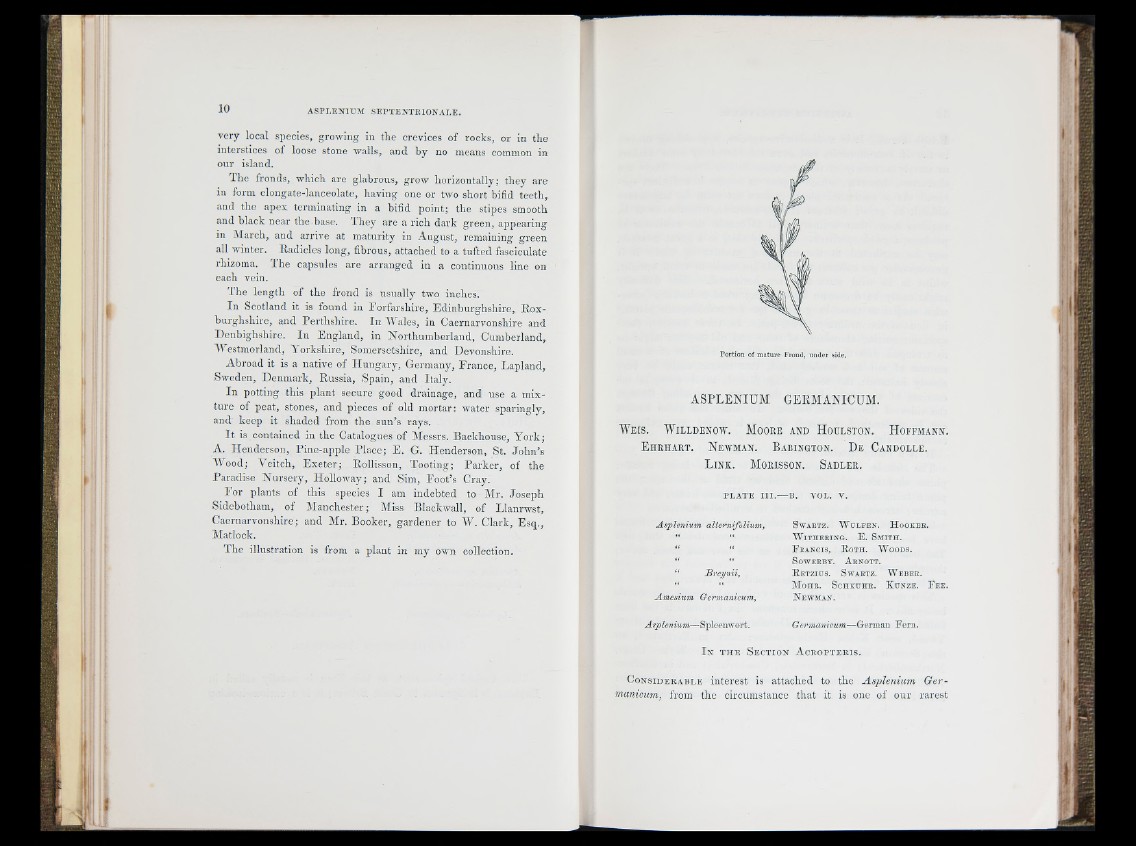
very local species, groAviiig in the crevices of rocks, or in the
interstices of loose stone walls, and by no means common in
our island.
The fronds, which are glabrous, grow horizontally; they are
in form elongate-lanceolate, having one or two short bifid teeth,
and the apex terminating in a bifid point; the stipes smooth
and black near the base. They are a rich dark green, appearing
in March, and arrive at maturity in August, remaining green
all Avinter. lladicles long, fibrous, attached to a tufted fasciculate
rhizoma. The capsules are arranged in a continuous line on
each vein.
The length of the frond is usually two inches.
In Scotland it is found in Forfarshire, Edinburghshire, Kox-
burghshire, and Perthshire. In M ales, in Caernarvonshire and
Denbighshire. In England, in Northumberland, Cumberland,
IWstmorland, A-orkshire, Somersetshire, and Devonshire.
Abroad it is a native of Hungary, Germany, France, Lapland,
Sweden, Denmark, Eussia, Spain, and Italy.
In potting this plant secure good drainage, and use a mixture
of peat, stones, and pieces of old mortar: water sparingly,
and keep it shaded from the sun’s rays.
It is contained in the Catalogues of Messrs. Backhouse, York;
A. Henderson, Pine-apple Place; E. G. Henderson, St. John’s
Mood; A-eitch, Exeter; Kollisson, Tooting; Parker, of the
Paradise Nursery, lioIloAvay; and Sim, Foot’s Cray.
For plants of this species I am indebted to Mr. Joseph
Sidebotham, of Manchester; iMiss Blackwall, of Llanrwst,
Caernarvonshire; and Mr. Booker, gardener to W . Clark, Esq.,
Matlock.
The illustration is from a plant in my OAvn collection.
ASPLENIUM GERMANICUM.
M’'e i s . W il l d e n o w . M o o r e a n d H o u l s t o n . H o f fm a n n .
E h r h a r t . N ew m a n . B a b in g t o n . D e C a n d o l l e .
L in k . M o r is s o n . S a d l e r .
P L A T E I I I . B . V O L . V .
Asp lén ium alternifolium,
“ Bi'epnii,
Amesium Germanicum,
Swaetz. W ulfen. H ooeee.
W ith e r in g . E . Smith .
F rancis, E oth. W oods.
SowERBT. Arnott.
F etzius. Swaetz. W eber.
WoHR. S chkuhr. K unze. F e e .
H ewman.
Germanicum—Asp lén ium—Spleenwort. German F e rn .
I n t h e S e c t io n A c r o p t e h i s .
C o n s id e r a b l e interest is attaclied to tlic Asplénium Ger-
manicum^ from the circumstance that it is one of our rarest
^1
i l